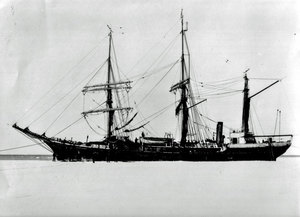 Deutschland at an unknown date
| |
| History | |
|---|---|
| Norway, later Germany, later Austria | |
| Owner | Christen Christensen, then Wilhelm Filchner, then Felix König |
| Builder | Risør shipyard, modified 1910 at Framnæs Mekaniske Værksted shipyard Sandefjord, Norway |
| Launched | 1905 |
| Fate | Sunk by a torpedo in the Adriatic Sea, 1917 |
| General characteristics | |
| Type | Barque |
| Tonnage | 598 GRT |
| Length | 48.5 m (159 ft) |
| Beam | 9.02 m (29.6 ft) |
| Draught | At stem, 5.49 m (18.0 ft); at stern 6.56 m (21.5 ft) |
| Propulsion | 330 hp (250 kW) Coal fired steam and sail |
| Speed | up to 10 knots |
Deutschland, known as Bjørn between 1905 and 1909, and Osterreich between 1914 and 1917, was a Norwegian whaling and sealing ship, built in 1905. She is best known for her role as the expedition ship in the Second German Antarctic Expedition of 1911–13. During this expedition she was taken further south in the Weddell Sea than any previous vessel in those waters, but became trapped, surviving an eight-months long drift in heavy ice before being freed. After the expedition she was sold to Austria as the basis for another planned Antarctic expedition, but this was cancelled on the outbreak of the First World War in August 1914. The ship served in the Austro-Hungarian Navy as a minesweeper until 1917, when she was sunk in a torpedo attack.